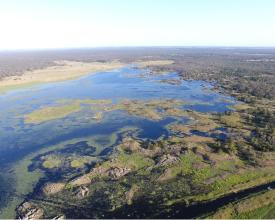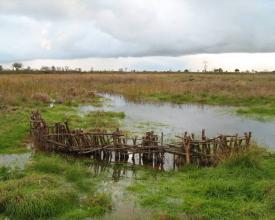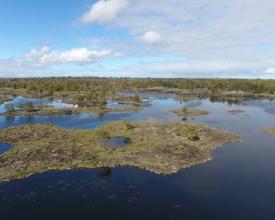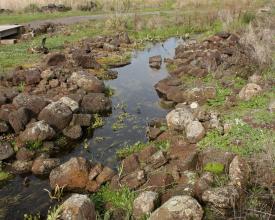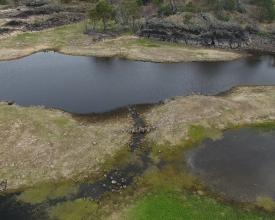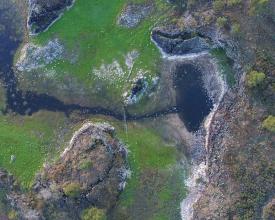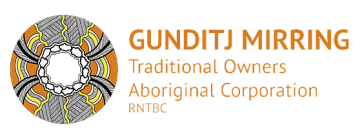
Mise en place d'une approche fondée sur les droits des propriétaires traditionnels pour le paysage culturel de Budj Bim et d'un système de gestion des connaissances "à double sens".
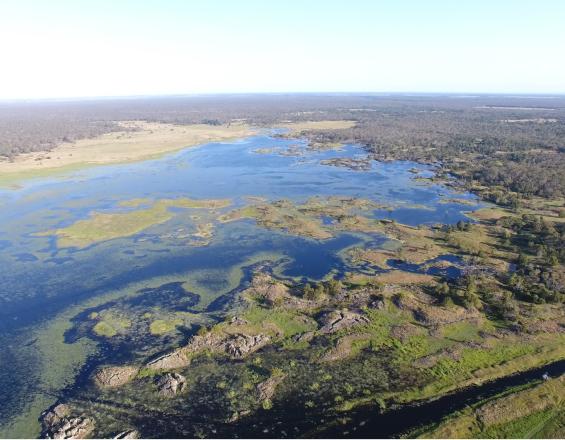
Le paysage culturel de Budj Bim se trouve dans le pays des Gunditjmara et est géré et protégé de manière globale dans le cadre d'un système comprenant les connaissances et les pratiques coutumières des Gunditjmara, en conjonction avec la législation nationale et nationale, les plans de gestion et les politiques et programmes associés. Le système de gestion combine les approches de la propriété traditionnelle et de la gestion adaptative, dans lesquelles la gouvernance et la prise de décision sont partagées.
Au début du XIXe siècle, la région de Gunditjmara a été occupée par les colons britanniques et l'accès à la région a été de plus en plus refusé aux propriétaires traditionnels jusqu'à la fin du XXe siècle. Les Gunditjmara ont conservé des liens avec le système aquacole grâce à leur connaissance des histoires de Budj Bim et des pratiques d'utilisation des terres qui y sont associées. Ces dernières années, le travail des Gunditjmara au sein de Budj Bim s'est de plus en plus tourné vers le renouvellement et la transmission des traditions et des pratiques culturelles grâce à l'accès et au contrôle des parties du pays qui leur appartiennent et qu'ils gèrent.
Contexte
Défis à relever
- Défis environnementaux: La gestion et la protection du bien-être écologique et social du paysage sont directement liées aux connaissances et aux pratiques traditionnelles des Gunditjmara. En outre, le changement climatique est potentiellement un défi majeur pour l'avenir de Budj Bim en tant que paysage éco-culturel.
- Défis culturels et sociaux: L'invasion du pays de Gunditjmara par les colons britanniques a entraîné une certaine perte des connaissances et des pratiques traditionnelles. De nombreuses pratiques culturelles ont été revitalisées et maintenues (par exemple, le tressage de paniers pour capturer les anguilles). La propriété du "territoire" est essentielle au bien-être et à l'épanouissement culturel des Gunditjmara.
- Défis économiques: Développement d'un tourisme durable et gérable dirigé et mis en œuvre par Gunditjmara dans l'ensemble du paysage culturel de Budj Bim, bien du patrimoine mondial.
Emplacement
Traiter
Résumé du processus
La solution reconnaît le rôle important joué par la propriété dans la gestion des paysages autochtones. Il est nécessaire de s'assurer que la propriété du territoire est entre les mains des peuples autochtones/indigènes et que les droits et obligations coutumiers des propriétaires traditionnels sont librement exercés par les communautés indigènes.
A Budj Bim, la propriété du territoire est entre les mains des propriétaires traditionnels et les droits et obligations coutumiers sont exercés par les Gunditjmara.
L'entretien et la sauvegarde des attributs et des valeurs du paysage culturel de Budj Bim ont été améliorés grâce au partage d'expertise entre les propriétaires traditionnels de Gunditjmara et les agences du gouvernement victorien. En outre, la transmission des connaissances de Gunditjmara est soutenue par les accords de gouvernance coutumière et par le programme des gardes forestiers de Budj Bim.
La protection partagée et intégrée est mise en œuvre par le système de gestion établi qui est basé sur un cadre de gouvernance intégrée et partagée et un cadre de gestion adaptative axé sur l'apprentissage continu et l'adaptation en évaluant continuellement le succès des actions dans la réalisation des objectifs de gestion et en permettant l'ajustement des actions de gestion.
Blocs de construction
Propriété foncière des propriétaires traditionnels de Gunditjmara
La propriété est un élément clé pour la protection et la gestion efficaces du paysage culturel de Budj Bim. Cependant, l'accès et la propriété de la terre ont été refusés aux Gunditjmara pendant une grande partie du 19ème siècle lorsque, après l'arrivée des envahisseurs coloniaux britanniques, le pays de Gunditjmara a été occupé et l'accès à la terre a été de plus en plus refusé aux propriétaires traditionnels de Gunditjmara jusqu'aux années 1980. Néanmoins, et tout au long de la période de colonisation, les Gunditjmara ont conservé des liens avec le système aquacole grâce à leur connaissance des histoires de Budj Bim et des pratiques d'utilisation des terres qui y sont associées.
À partir de 1984, les terres ont été de plus en plus restituées et achetées par les propriétaires traditionnels Gunditjmara. En 2007, avec la reconnaissance des droits fonciers autochtones de Gunditjmara, certaines parties du pays ont été restituées à Gunditjmara. Aujourd'hui, les organisations aborigènes possèdent et gèrent le site du patrimoine mondial de Budj Bim, à l'exception du parc national de Budj Bim, qui est géré en coopération par les propriétaires traditionnels de Gunditjmara et le gouvernement de l'État de Victoria.
La propriété des terres permet aux traditions, connaissances et pratiques culturelles des Gunditjmara de s'exprimer dans le présent et dans l'avenir, grâce à la reconnaissance des droits et obligations des Gunditjmara en matière de garde et de propriété autochtone.
Facteurs favorables
Cet élément constitutif est rendu possible par la reconnaissance de l'Aboriginal Land (Lake Condah and Framlingham Forest) Act 1987 (Vic.) et la détermination du titre autochtone des Gunditjmara en 2007 en vertu du Native Title Act 1993 (Cwlth) et d'autres accords de gestion conjointe avec le gouvernement de l'État de Victoria.
Leçon apprise
- Le retour du pays et le renouvellement des connaissances et des pratiques des Gunditjmara - notamment en matière d'aquaculture - ont été des actions puissantes qui ont permis aux Gunditjmara de conserver leur sentiment d'appartenance, leur esprit et leur sentiment d'appartenance au lieu. Par conséquent, les générations actuelles ont pu grandir dans un pays appartenant à Gunditjmara, ce qui constitue un puissant mécanisme de renforcement culturel intergénérationnel.
- La propriété de la terre est un besoin fondamental pour la gestion et la conservation des terres et des paysages aborigènes et indigènes, et elle est essentielle au bien-être et à l'épanouissement culturel des Gunditjmara. Le bien du patrimoine mondial de Budj Bim est composé de terres possédées ou gérées conjointement par la Gunditj-Mirring Traditional Owners Aboriginal Corporation et la Winda-Mara Aboriginal Corporation. Par conséquent, le site et ses limites sont assurés d'un consentement libre, préalable et éclairé en vertu de leur propriété, de leur gestion et de leur contrôle.
- La propriété foncière des Gunditjmara a démontré aux gouvernements que les Gunditjmara ont la capacité de gérer leur pays et a permis aux Gunditjmara de s'engager de plus en plus auprès de la communauté au sens large.
Gunditjmara Propriétaire traditionnel Droits et obligations coutumiers
Le paysage culturel de Budj Bim est situé dans le pays traditionnel de Gunditjmara. En tant que tel, les Gunditjmara ont des droits, des responsabilités et des obligations de longue date pour prendre soin du pays.
Les Gunditjmara ont donc des droits, des responsabilités et des obligations de longue date pour prendre soin de leur pays, sur la base des connaissances et des pratiques traditionnelles et permanentes des Gunditjmara.
Les traditions, connaissances et pratiques culturelles des Gunditjmara sont évidentes dans l'aquaculture des Gunditjmara, comme en témoigne l'évolution des pratiques de gestion, de stockage et de récolte des kooyangs (anguilles), ainsi que la manipulation, la modification et la gestion des flux d'eau qui en découlent. Les connaissances et les pratiques aquacoles des Gunditjmara comprennent également l'approvisionnement en herbes pour le tressage des gnarraban (paniers kooyang), les représentations traditionnelles de l'aquaculture des Gunditjmara (par exemple, les dessins complexes réalisés sur les manteaux en peau d'opossum), l'adaptation des techniques de capture traditionnelles (par exemple, la pêche à la baleine, la pêche à l'oie, etc, l'adaptation des techniques de capture traditionnelles (par exemple, l'utilisation de paniers en treillis métallique et de caisses en bois pour contenir les kooyang) et les expressions artistiques contemporaines et créatives de l'aquaculture de Gunditjmara, comme en témoignent les contes, les danses, les chants, les objets artisanaux et les sculptures.
Facteurs favorables
L'affirmation des droits des Gunditjmara a conduit à leur reconnaissance par les gouvernements australiens à partir des années 1980 - l'Aboriginal Land (Lake Condah and Framlingham Forest) Act 1987 (Vic.) a été la première législation à reconnaître les Gunditjmara et leurs droits.
Les droits des Gunditjmara sont reconnus par la loi de 1993 sur les titres autochtones du gouvernement australien et par la loi de 2006 sur le patrimoine aborigène du gouvernement victorien. Les droits et obligations traditionnels et coutumiers sont mis en œuvre par le biais d'accords de gouvernance.
Leçon apprise
- La propriété de la terre est un élément clé pour permettre l'exercice des droits et obligations coutumiers et traditionnels.
- L'affirmation de l'identité et des droits des Gunditjmara était essentielle dans la lutte pour leur reconnaissance par le gouvernement.
- Dans un contexte colonial occidental, prouver les droits et obligations des Gunditjmara à l'égard du pays nécessitait un engagement avec les communautés de recherche et les technologies afin de "prouver" l'existence et l'étendue des connaissances et pratiques ancestrales - et de les faire reconnaître en termes occidentaux.
Application des pratiques traditionnelles permanentes par le biais des connaissances coutumières et enregistrées
La colonisation et l'occupation du pays de Gunditjmara ont entraîné la perte de certaines connaissances traditionnelles concernant le fonctionnement du système d'aquaculture de Gunditjmara, en particulier lorsque l'accès à ces lieux a été restreint en raison de leur propriété privée par des non-Aborigènes. À partir de 1984, certaines parties des terres ont été progressivement restituées et achetées par des propriétaires traditionnels. Avec la restitution des terres aux Gunditjmara à la suite de la détermination des titres de propriété autochtones en 2007, les Gunditjmara se sont concentrés sur la restauration des flux d'eau et la revitalisation du système d'aquaculture. Les connaissances et les pratiques contemporaines des Gunditjmara sont renouvelées et revitalisées par les connaissances coutumières héritées. Le maintien de l'expertise traditionnelle (à la fois en termes de connaissances et de pratiques) des propriétaires traditionnels de Gunditjmara, associé à l'expertise des agences gouvernementales en matière de gestion des zones protégées, a permis la mise en place d'un modèle de gestion adaptative amélioré par le biais d'un "apprentissage à double sens". Les connaissances coutumières de Gunditjmara concernant les flux d'eau culturels remontent à plus de 6 700 ans.
Facteurs favorables
La poursuite des pratiques traditionnelles - en particulier l'entretien et la création de canaux (yereoc), de déversoirs (en pierre et en bois) et de barrages, ainsi que la modification des étangs et des dolines - est rendue possible par les connaissances enregistrées (y compris les souvenirs personnels, des aînés et de la communauté) et la documentation historique. En outre, la restitution de la propriété des lieux aux propriétaires traditionnels de Gunditjmara est un élément clé de la poursuite des pratiques aquacoles.
Leçon apprise
- Le débit d'eau - qui est un attribut du système d'aquaculture de Gunditjmara - a été considérablement rétabli dans le système Tae Rak-Killara grâce à l'initiative de Gunditjmara de construire un déversoir sur Tae Rak en 2010. Cette importante restauration écologique et le retour d'eau supplémentaire dans le système d'aquaculture continuent d'améliorer la compréhension du système et ont permis aux Gunditjmara de se remémorer les connaissances orales et écrites associées au fonctionnement du réseau d'aquaculture du kooyang (anguille).
- Le retour du pays et le renouvellement des connaissances et pratiques continues des Gunditjmara concernant l'aquaculture ont été des actions puissantes qui ont soutenu le sens de l'esprit des Gunditjmara et leur sentiment d'appartenance au lieu.
Programme des gardes forestiers Budj Bim
Le programme des gardes forestiers de Budj Bim est un élément clé des dispositions institutionnelles pour la gestion et la conservation du paysage éco-culturel de Budj Bim. Le programme est financé par le gouvernement australien (par le biais de son programme de zones protégées indigènes) et géré par la Winda-Mara Aboriginal Corporation. Il emploie des rangers à plein temps encadrés par les anciens de Gunditjmara, qui leur apportent leurs connaissances et leur soutien traditionnels et culturels. Les gardes forestiers de Budj Bim sont responsables de la gestion des zones protégées de Budj Bim et de Tyrendarra. Ils sont responsables d'un large éventail d'activités de gestion, notamment la gestion de la flore et de la faune indigènes, la construction et l'entretien des sentiers de randonnée, les visites guidées et la surveillance.
Les gardes forestiers de Budj Bim jouent un rôle essentiel en assurant la continuité culturelle et la transmission des connaissances et des pratiques traditionnelles et contemporaines des Gunditjmara d'une génération à l'autre.
Facteurs favorables
Le programme des zones protégées indigènes est financé par le programme Indigenous Advancement Strategy du gouvernement australien et le Budj Bim Ranger Program est mis en œuvre par les Gunditjmara de manière à soutenir le travail sur le territoire en tant qu'activité culturelle garantissant la transmission des connaissances et des pratiques. Sans le financement du gouvernement, les Gunditjmara n'ont pas - à l'heure actuelle - les ressources nécessaires pour gérer le pays.
Leçon apprise
- Ce mode de gestion du paysage culturel de Budj Bim permet aux propriétaires traditionnels de Gunditjmara d'orienter les approches de gestion sur le terrain en fonction des connaissances, des traditions et des pratiques culturelles.
- Les activités de gestion et de conservation menées par les propriétaires traditionnels dans le cadre du programme des gardes forestiers de Budj Bim ont permis de contrôler et d'endiguer dans une large mesure les mauvaises herbes et les animaux nuisibles dans l'environnement, et de revégétaliser largement les espèces végétales indigènes, notamment l'eucalyptus, l'acacia, la bursaria et d'autres arbres, arbustes, carex, plantes couvre-sol, herbes et graminées indigènes.
- Les rangers sont chargés de lutter contre les plantes et les animaux nuisibles ; les travaux de revégétalisation à l'aide d'espèces végétales indigènes, dont beaucoup ont une importance culturelle, améliorent l'environnement naturel et culturel.
- Les rangers jouent un rôle clé dans les activités de sensibilisation et d'éducation par le biais du programme des écoles invitées. Les gardes forestiers de Budj Bim gèrent ce programme pour les groupes scolaires. Environ 50 visites de ce type ont lieu chaque année (2017).
- Activités de gestion et de surveillance des terres dans l'ensemble du paysage culturel de Budj Bim.
Gouvernance intégrée et partagée
La protection coutumière et législative du paysage culturel de Budj Bim est rendue possible et mise en œuvre par un système de gouvernance bien établi. Au niveau local, les organes de gouvernance, de décision et d'administration qui supervisent et coopèrent à la protection et à la gestion du lieu sont le Conseil de Budj Bim, la Corporation autochtone des propriétaires traditionnels de Gunditj Mirring (GMTOAC) et la Corporation autochtone de Winda-Mara.
- Le conseil de Budj Bim est composé de représentants des propriétaires traditionnels de Gunditjmara (la majorité des membres du conseil) et du gouvernement victorien. Son rôle est de superviser la gestion coopérative du paysage écoculturel du parc national de Budj Bim afin d'atteindre les objectifs culturels et écologiques par le biais d'une prise de décision commune. Il démontre le partage d'expertise "à double sens" entre les propriétaires traditionnels de Gunditjmara et les agences du gouvernement de l'État de Victoria.
- Le GMTOAC gère les droits de propriété des Gunditjmara et encourage le maintien des liens avec la région de Gundijmara par le biais de ses programmes et projets de protection de la région. Le GMTOAC possède et gère la zone protégée indigène de Budj Bim et la mission du lac Condah.
- La Winda-Mara Aboriginal Corporation est propriétaire et gestionnaire de la zone protégée indigène de Tyrendarra.
Facteurs favorables
Cet élément constitutif est rendu possible par la reconnaissance des droits de propriété des Gunditjmara en 2007 en vertu du Native Title Act 1993 (Cwlth) et par d'autres accords de gestion conjointe avec le gouvernement du Victoria qui ont permis un système de partage d'expertise "à double sens" entre les connaissances traditionnelles et l'expertise des agences gouvernementales (écologie, gestion des risques, etc.). Le conseil Budj Bim, en particulier, permet d'établir et de maintenir en permanence des relations entre les propriétaires traditionnels de Gunditjmara et le gouvernement.
Leçon apprise
- L'implication directe des agences gouvernementales dans le Conseil du Budj Bim garantit que les principales parties prenantes sont "dans la même pièce" et qu'une interaction régulière renforce la confiance et la capacité d'un "apprentissage réciproque". Si le Conseil de Budj Bim est officiellement chargé de la gestion du parc national de Budj Bim, il soutient également la planification stratégique pour l'ensemble du paysage de Budj Bim.
- L'approche de gouvernance intégrée et partagée entre Gunditjmara et le gouvernement soutient la mise à disposition de ressources pour prendre soin du pays et y travailler.
Cadre de gestion adaptative
La sauvegarde des valeurs du paysage culturel de Budj Bim - en particulier dans le contexte des changements climatiques - repose sur les connaissances traditionnelles des Gunditjmara et sur un cadre de gestion adaptative visant à permettre un apprentissage et une adaptation continus en évaluant en permanence le succès des mesures prises pour atteindre les objectifs de gestion et en permettant d'ajuster les mesures de gestion à l'avenir afin d'atteindre au mieux les objectifs de gestion. La gestion adaptative vise à intégrer des composantes spécifiques de la gestion afin de fournir un cadre qui vérifie systématiquement les hypothèses, favorise l'apprentissage et l'amélioration continue, et fournit des informations opportunes pour soutenir les décisions de gestion. Elle comprend l'utilisation du suivi, de l'évaluation, de l'établissement de rapports et de l'amélioration pour renforcer les connaissances de Gunditjmara, mettre en œuvre une approche d'évaluation des risques, stocker et gérer les informations, et utiliser la technologie pour faciliter les activités de gestion des terres.
Enfin, ce cadre vise à renforcer et à encourager les liens entre un environnement sain et une société saine, qui sont mis en évidence dans le principe de Gunditjmara Ngootyoong Gunditj, Ngootyoong Mara (pays sain, peuple sain), qui est étroitement aligné sur celui de Parks Victoria (parcs sains, peuple sain).
Facteurs favorables
La coordination et la coopération partagées dans le cadre de la gestion adaptative sont rendues possibles par la gouvernance et la prise de décision partagées par la Corporation autochtone des propriétaires traditionnels de Gunditj Mirring (GMTOAC), le Conseil de Budj Bim et la Corporation autochtone de Winda Mara. Le cadre de gestion adaptative est activé par les plans de gestion des aires protégées, le dossier de nomination au patrimoine mondial et le plan de gestion du sud-ouest du Ngootyoong Gunditj Ngootyoong Mara - Stone Country.
Leçon apprise
Le cadre permet un apprentissage permanent en évaluant continuellement le succès des mesures prises pour atteindre les objectifs de gestion et en soutenant l'ajustement des mesures de gestion à l'avenir. Le cadre exige l'intégration de divers éléments de gestion afin de fournir une approche qui vérifie systématiquement les hypothèses, favorise l'apprentissage et l'amélioration continue et fournit des informations opportunes pour soutenir les décisions de gestion.
l'apprentissage et l'amélioration continue, et qui fournit des informations en temps utile pour soutenir les décisions de gestion. En fin de compte, le cadre cherche à renforcer et à favoriser les liens entre les connaissances et les pratiques Gunditjmara d'un environnement sain et d'une société saine (Ngootyoong Gunditj, Ngootyoong Mara - Healthy Country, Healthy People).
Le principal enseignement tiré de la création d'un cadre de gestion adaptative efficace a été l'engagement de la communauté locale au sens large, y compris des propriétaires fonciers voisins. Cela s'est fait en allant à la rencontre des communautés (par exemple, en organisant des conférences) et en les invitant sur les terres de Gunditjmara pour partager leurs points de vue en matière de gestion.
Impacts
Cette solution souligne l'importance de la propriété autochtone et offre un exemple direct de la raison pour laquelle les biens du patrimoine mondial dont les valeurs exceptionnelles sont associées aux terres, aux eaux et aux cultures des Premières nations devraient être gérés par le biais de la propriété traditionnelle et/ou d'accords de gestion conjointe.
- Environnement: gestion durable des systèmes d'aquaculture et des ressources naturelles sur la base d'un cadre de gestion adaptative fondé sur les connaissances et les pratiques traditionnelles et occidentales.
- Culturel et social: La propriété des Gunditjmara, ainsi que les droits et obligations envers le pays, ont vu une résurgence et un épanouissement de l'expression créative à travers l'art, l'artisanat (y compris le tissage, la fabrication de manteaux en peau d'opossum), la danse, le chant et la sculpture qui renforcent la spiritualité des Gunditjmara et leur lien avec le pays. La propriété foncière et la gestion active permettent aux Gunditjmara de continuer à prendre soin du paysage culturel de Budj Bim. Aujourd'hui, les traditions, les connaissances et les pratiques culturelles des Gunditjmara continuent de faire partie du lien avec le Budj Bim, vieux de six millénaires.
- L'économie: Les zones humides aquacoles aménagées des Gunditjmara ont historiquement fourni la base économique nécessaire à la subsistance de grands groupes de personnes vivant à proximité de Tai Rak (lac Condah). Aujourd'hui, Budj Bim offre une opportunité de développement d'une industrie touristique durable et inclusive, dirigée et gérée par les Gunditjmara.
Bénéficiaires
Les principaux bénéficiaires sont les propriétaires traditionnels de Gunditjmara ainsi que le pays de Gundijmara, car les propriétaires traditionnels et le pays sont inextricablement liés dans les notions de "prise en charge du pays". Le bien-être écologique et celui de la communauté sont profondément liés.
Objectifs de développement durable
Histoire
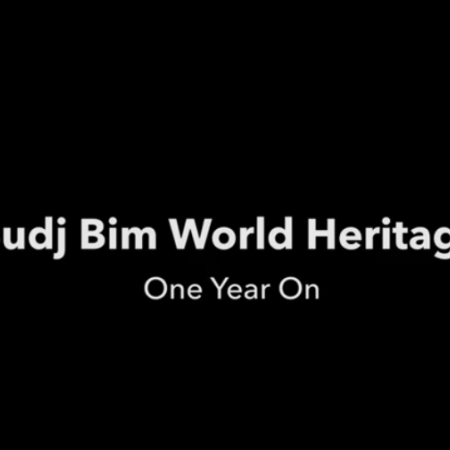
En juillet 2019, le paysage culturel de Budj Bim a été inscrit par le Comité du patrimoine mondial sur la Liste du patrimoine mondial de l'UNESCO en tant que série de trois éléments sériels contenant l'un des systèmes d'aquaculture les plus étendus et les plus anciens au monde.
Le paysage culturel de Budj Bim est le premier endroit en Australie à être inscrit sur la Liste du patrimoine mondial de l'UNESCO uniquement pour son importance culturelle aborigène. La proposition d'inscription a été menée par la communauté et dirigée par les propriétaires traditionnels de Gunditjmara.
L'inscription au patrimoine mondial couronne un processus de préparation de la proposition d'inscription qui a duré 17 ans et qui célèbre la valeur exceptionnelle du paysage culturel de Budj Bim et des propriétaires traditionnels de Gunditjmara.
La vidéo "Budj Bim - One Year On" (https://www.youtube.com/watch?v=DtPOzOWa4Xs) se penche sur le chemin vers le patrimoine mondial, un an après l'inscription, et sur l'impact des défis mondiaux.

